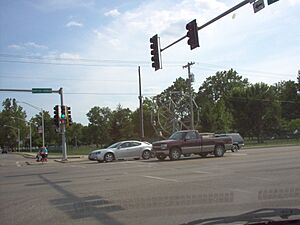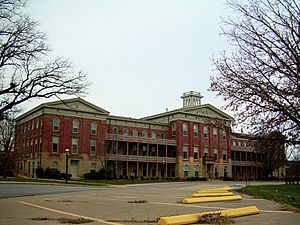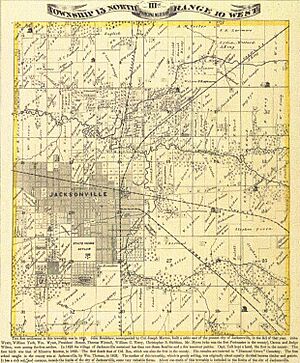Jacksonville, Illinois facts for kids
Quick facts for kids
Jacksonville, Illinois
|
|
|---|---|
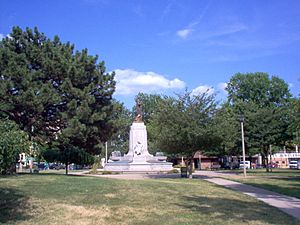
Civil War monument in Central Park
|
|
| Nickname(s):
"The Athens of the West"
|
|
| Motto(s):
"Where People Make The Difference"
|
|
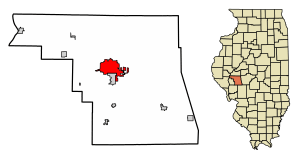
Location in Morgan County, Illinois
|
|
| Country | United States |
| State | Illinois |
| County | Morgan |
| Government | |
| • Type | Mayor-Council |
| Area | |
| • Total | 10.76 sq mi (27.87 km2) |
| • Land | 10.56 sq mi (27.36 km2) |
| • Water | 0.20 sq mi (0.51 km2) |
| Elevation | 587 ft (179 m) |
| Population
(2020)
|
|
| • Total | 17,616 |
| • Density | 1,667.71/sq mi (643.94/km2) |
| Time zone | UTC−6 (CST) |
| • Summer (DST) | UTC−5 (CDT) |
| ZIP Code |
62650
|
| Area codes | 217, 447 |
| FIPS code | 17-38115 |
| GNIS feature ID | 2395451= |
Jacksonville is a city in Illinois, United States. It is the main city of Morgan County. In 2020, about 17,616 people lived there. Jacksonville is known for its schools. It is home to Illinois College, the Illinois School for the Deaf, and the Illinois School for the Visually Impaired. It was also once home to MacMurray College. Jacksonville is the main city of the Jacksonville Micropolitan Statistical Area. This area includes all of Morgan and Scott counties.
Contents
History of Jacksonville
Jacksonville was started in 1825. This was two years after Morgan County was formed. The first people to settle here came from New England. They were part of a group of farmers who moved west. They came after the Erie Canal was finished and the Black Hawk War ended.
When they arrived, the area was mostly thick forest and wild prairie. These settlers built farms and roads. They also set up government buildings and postal routes. They valued education and started many schools. They also strongly supported ending slavery.
The town grew quickly. A town square was soon created. In 1829, a new school was planned for Illinois. Students from Yale College came to help start it. This school became Illinois College. It was one of the first colleges in the Midwest.
A new courthouse was built in the town square. Churches were constructed, and stores were opened. By 1834, Jacksonville was the largest city in Illinois. It was much bigger than Chicago at that time.
In the 1830s, Native Americans were moved from their homes. The Potawatomi people passed through Jacksonville in 1838. They called this journey their "Trail of Death." They were forced to move to dry lands to the west.
Jacksonville became known for its education. State schools like the Illinois School for the Deaf and the Illinois School for the Visually Impaired were built here. A school for girls, the Illinois Conference Female Academy, was also founded. It later became MacMurray College. By 1850, Illinois College gave out the first college degrees in the state. It also opened the first medical school in Illinois. Because of this, Jacksonville was called "Athens of the West."
In 1851, Illinois opened its first state mental hospital in Jacksonville. This hospital became a major employer in the area.
Abraham Lincoln, who later became president, sometimes had legal work in Jacksonville. On September 6, 1856, Lincoln gave a strong speech against slavery in Central Park. It lasted over two hours. A painting of this event is on a building near the town square.
The Woodlawn Farm was built in 1840. It became an important stop on the Underground Railroad. This was a secret network that helped enslaved people escape to freedom. You can visit this historical site in the summer.
One of Lincoln's early political rivals, Stephen A. Douglas, moved to Jacksonville in 1833. He started his political career here. He quickly became important in Illinois politics. He was elected to the House of Representatives in 1842.
Jacksonville in the 1900s and Today
From 1892 to 1910, Jacksonville had minor league baseball teams. These included the Jacksonville Jacks and Jacksonville Lunatics. They played at League Park.
In 1911, Jacksonville changed its government style. It adopted the city commission form. George W. Davis was the first mayor under this new system.
In 1965, Capitol Records opened a record pressing plant in Jacksonville. This plant made vinyl records for popular bands like the Beatles. Later, it made audiocassettes, CDs, and DVDs for many artists.
At its busiest, the plant, owned by EMI Records, had over 1,000 workers. It was a very important place in the music industry. For example, it produced records for country artist Garth Brooks. EMI held a "thank-you" lunch for its workers in 1995. However, in 2004, EMI stopped making products in Jacksonville.
Geography and Climate
Jacksonville is located at 39°43′55″N 90°14′4″W / 39.73194°N 90.23444°W. It is about 32 miles (51 km) west of Springfield, the state capital. It is also about 70 miles (113 km) east of Hannibal, Missouri.
Interstate 72 runs south of the city. You can get to it from Exits 64 and 68. U.S. Route 67 is just west of the city. It goes south to Alton and north to Macomb. Other state routes also pass through or near Jacksonville.
The city is in the middle of flat, fertile farmland. Mauvaisterre Creek flows into Lake Mauvaisterre. This is a small lake surrounded by parkland. About 4 miles (6 km) south of the city is Lake Jacksonville. This lake is 476 acres (193 ha) and has 18.6 miles (29.9 km) of shoreline. Field & Stream magazine once called Lake Jacksonville the "Number One Fishing Spot in Illinois."
Jacksonville's Weather
| Climate data for Jacksonville 2E, Illinois (1991–2020 normals, extremes 1895–present) | |||||||||||||
|---|---|---|---|---|---|---|---|---|---|---|---|---|---|
| Month | Jan | Feb | Mar | Apr | May | Jun | Jul | Aug | Sep | Oct | Nov | Dec | Year |
| Record high °F (°C) | 75 (24) |
80 (27) |
91 (33) |
94 (34) |
103 (39) |
107 (42) |
114 (46) |
112 (44) |
106 (41) |
98 (37) |
84 (29) |
74 (23) |
114 (46) |
| Mean daily maximum °F (°C) | 36.0 (2.2) |
41.1 (5.1) |
52.4 (11.3) |
64.9 (18.3) |
74.8 (23.8) |
83.3 (28.5) |
86.5 (30.3) |
85.2 (29.6) |
80.0 (26.7) |
67.7 (19.8) |
53.0 (11.7) |
41.2 (5.1) |
63.8 (17.7) |
| Daily mean °F (°C) | 27.1 (−2.7) |
31.2 (−0.4) |
41.2 (5.1) |
52.6 (11.4) |
63.3 (17.4) |
72.1 (22.3) |
75.3 (24.1) |
73.4 (23.0) |
66.7 (19.3) |
55.0 (12.8) |
42.5 (5.8) |
32.2 (0.1) |
52.7 (11.5) |
| Mean daily minimum °F (°C) | 18.1 (−7.7) |
21.4 (−5.9) |
30.1 (−1.1) |
40.3 (4.6) |
51.7 (10.9) |
60.8 (16.0) |
64.0 (17.8) |
61.7 (16.5) |
53.5 (11.9) |
42.3 (5.7) |
31.9 (−0.1) |
23.3 (−4.8) |
41.6 (5.3) |
| Record low °F (°C) | −24 (−31) |
−28 (−33) |
−14 (−26) |
10 (−12) |
26 (−3) |
36 (2) |
43 (6) |
39 (4) |
23 (−5) |
9 (−13) |
−5 (−21) |
−21 (−29) |
−28 (−33) |
| Average precipitation inches (mm) | 1.93 (49) |
1.72 (44) |
2.81 (71) |
4.27 (108) |
4.82 (122) |
4.89 (124) |
3.96 (101) |
3.39 (86) |
3.50 (89) |
2.97 (75) |
3.01 (76) |
1.98 (50) |
39.25 (997) |
| Average snowfall inches (cm) | 5.1 (13) |
4.3 (11) |
2.0 (5.1) |
0.3 (0.76) |
0.0 (0.0) |
0.0 (0.0) |
0.0 (0.0) |
0.0 (0.0) |
0.0 (0.0) |
0.0 (0.0) |
1.0 (2.5) |
3.5 (8.9) |
16.2 (41) |
| Average precipitation days (≥ 0.01 in) | 7.7 | 7.2 | 10.8 | 12.3 | 13.3 | 10.5 | 8.7 | 8.9 | 8.2 | 9.9 | 9.8 | 8.1 | 115.4 |
| Average snowy days (≥ 0.1 in) | 3.9 | 3.2 | 1.4 | 0.2 | 0.0 | 0.0 | 0.0 | 0.0 | 0.0 | 0.0 | 0.6 | 3.1 | 12.4 |
| Source: NOAA | |||||||||||||
People of Jacksonville
| Historical population | |||
|---|---|---|---|
| Census | Pop. | %± | |
| 1850 | 2,745 | — | |
| 1860 | 5,528 | 101.4% | |
| 1870 | 9,203 | 66.5% | |
| 1880 | 10,927 | 18.7% | |
| 1890 | 12,935 | 18.4% | |
| 1900 | 15,078 | 16.6% | |
| 1910 | 15,326 | 1.6% | |
| 1920 | 15,713 | 2.5% | |
| 1930 | 17,747 | 12.9% | |
| 1940 | 19,844 | 11.8% | |
| 1950 | 20,387 | 2.7% | |
| 1960 | 21,690 | 6.4% | |
| 1970 | 20,553 | −5.2% | |
| 1980 | 20,284 | −1.3% | |
| 1990 | 19,324 | −4.7% | |
| 2000 | 18,940 | −2.0% | |
| 2010 | 19,446 | 2.7% | |
| 2020 | 17,616 | −9.4% | |
| U.S. Decennial Census | |||
In 2010, Jacksonville had 19,446 people living in 7,357 households. About 24.3% of households had children under 18. The average household size was 2.23 people.
The population was spread out by age. About 22.0% were under 18. About 14.2% were between 18 and 24. The median age was 37 years old. For every 100 females, there were about 91 males.
The average income for a household in the city was $40,670. For families, it was $56,343. About 18% of the people in Jacksonville lived below the poverty line. This included 24.9% of those under 18.
Businesses in Jacksonville
Jacksonville is home to the Eli Bridge Company. This company makes Ferris wheels and other fun rides like the Scrambler. W.E. Sullivan started the company in 1900. He was inspired after seeing the first Ferris Wheel at the World's Columbian Exposition.
Jacksonville was also home to the J. Capps & Son Company. This was one of the largest makers of clothes and fabrics in the United States.
Today, companies like Reynolds Group Holdings and Nestlé Beverage Co. have factories in Jacksonville. From 1952 to 2008, a food processing plant for ACH Food Companies was also located here.
Education in Jacksonville
Jacksonville has one private four-year college, Illinois College. It is the second oldest college in Illinois. It was founded in 1829 by students from Yale College. Illinois College was the first in the state to give out a college degree in 1835. It also had Illinois' first medical school for a short time. The college became co-educational, meaning both boys and girls could attend, in 1903.
Jacksonville is also home to three state-run schools. These include the Illinois School for the Deaf and the Illinois School for the Visually Impaired. The Jacksonville Correctional Center is also here. Lincoln Land Community College has a center in Jacksonville too.
The city has three high schools: two private and one public. Routt Catholic High School is one of the private schools. Jacksonville School District 117 runs the public schools. This includes six elementary schools, one middle school, and Jacksonville High School.
Media and News
The city's daily newspaper is the Jacksonville Journal-Courier. It is the oldest newspaper in Illinois that has been published without stopping since 1830.
Jacksonville also has a weekly newspaper called The Source.
Several radio stations broadcast in Jacksonville. These include WCIC 90.7-FM, WLDS 1180-AM, WEAI 107.1-FM, WJVO 105.5-FM, and WJIL on 102.9-FM and 1550-AM.
NOAA Weather Radio station WXM90 also broadcasts from near Jacksonville. It gives weather warnings and emergency alerts for the area.
Culture and Arts
In 2005, the musician Sufjan Stevens released an album called Illinois. One song on the album, "Jacksonville," talks about places in the town. It also mentions stories about how the town might have gotten its name.
The Grammy-winning song "John Doe #24" by Mary Chapin Carpenter tells a story from Jacksonville. It's about a blind and deaf man found in Jacksonville in 1945. He was hospitalized and stayed in institutions for almost 50 years. No one ever found out his name or where he came from.
Jacksonville has many cultural activities. These include the Jacksonville Symphony Orchestra and the Jacksonville Theatre Guild. There is also the Art Association of Jacksonville and its David Strawn Art Gallery. The Jacksonville Area Museum has many historical items.
Jacksonville is also special because it has many pipe organs for a city its size. There are eleven organs in local churches and colleges.
A group of Portuguese people have lived near Jacksonville since the 1800s. Their ancestors came from the island of Madeira in 1849. They moved to the United States to escape discrimination for their Protestant faith.
Fun Things to Do in Jacksonville
Jacksonville Speedway is a dirt racetrack. It is located at the Morgan County Fairgrounds and started in 1912. The track was first a flat 1/2 mile track. Now, it is a banked 1/4 mile track. It can seat 2,000 people.
Nichols Park is a park on the south side of Jacksonville. It has a playground, a golf course, a lake, and a community pool.
In December, you can see the "World's Tallest Advent Calendar" in downtown Jacksonville. The Farmers State Bank and Trust building displays the 24 days leading up to Christmas in its windows.
Notable People
See also
 In Spanish: Jacksonville (Illinois) para niños
In Spanish: Jacksonville (Illinois) para niños




